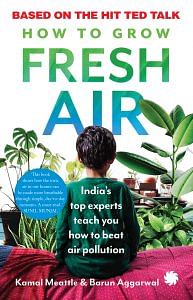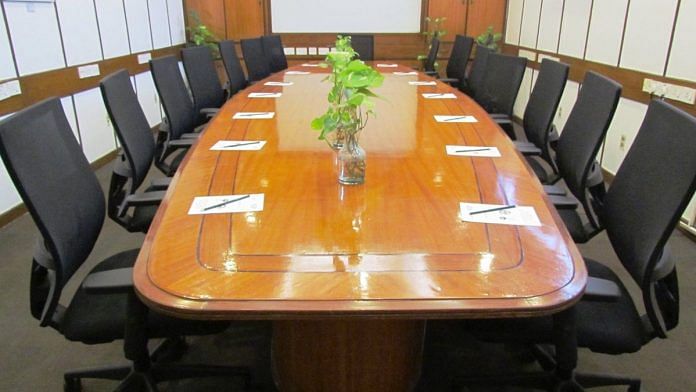In their book How to Grow Fresh Air, Kamal Meattle and Barun Aggarwal write about how simple things and determination can help curb air pollution.
One morning, around twenty-six years ago, I woke up and couldn’t breathe. I should have seen it coming, but I didn’t. The problem began with an unsuspecting cough followed by allergies. I turned to cough medicines, anti-allergy puffs and inhalers. But soon I realized that this sudden inability to breathe was different from a regular allergy. It was as if someone was choking me. I was terrified. I rushed to my doctor immediately.
After several tests, his diagnosis was grim. He told me that my lung capacity had dropped to 70 per cent. In other words, the 4 to 6 litres of air my lungs could take in had now whittled down to just a little more than 3 to 4 litres. I knew that was reason enough to panic, because our lungs, like many other organs in our body, are usually built to handle excess. In our day-to-day life, we don’t use more than 30 per cent of our lung capacity. But after the diagnosis, the problem became all too real. I couldn’t understand what had gone wrong. I had always been careful. What could have possibly led to a part of my lungs giving up on me? After several days, my doctor had the answer. Delhi’s air was destroying my lungs, bit by bit.
…
My doctor gave me two choices. One, leave the city and move to a cleaner, greener place. Two, stay back in Delhi and fight, albeit at a dangerous personal cost. I chose the second option. I was forty-eight years old then, and I neither had the will nor the desire to run away to a foreign land and start from scratch. Moreover, leaving the country felt like a betrayal because Delhi was my home. This was where I had built a life for myself, where my friends and family were. This was where I belonged. I was aware that this was either the bravest or the most foolish thing to do. It was a decision that could change the course of my life. And I was very cognizant of the fact that it could shorten my life too. But I decided I was not leaving. I chose to stay back in Delhi and find a solution to the air pollution problem and my deteriorating health. It was a mad gamble, because I didn’t have the luxury of time. Whatever I had to do I knew I had to do it quickly.
…
As we started digging deeper into the air pollution problem, we kept coming back to the same answer – National Aeronautics and Space Administration (NASA). NASA was the only research facility in the world that was experimenting with growing fresh air to fuel colonies in other planets like Mars. It was a great lead. Even though we couldn’t get any more data on NASA’s research because their information was classified, we knew we’d stumbled across an idea worth exploring. Of course, we weren’t setting out to clean ambient or outside air. That would have made our project immeasurably difficult. What we were looking for was a solution to purify the air in our homes and offices, because that’s where we spend most of our time. We began to ask the questions that NASA was tackling. How does one go about growing fresh air – this invisible, omnipotent substance that is responsible for all life on earth? It was like playing God. Baffling though the question was, the answer was even more ridiculous. Especially because it was around us the whole time we were scratching our heads. Plants. Yes, it was as simple as that.
…
We turned to IIT and The Energy and Resources Institute (TERI) to help us. TERI had also tested Delhi’s air over the course of twelve months, in all seasons, at different levels, indoors and outdoors. The benzene content in Delhi’s atmosphere had been measured by the Central Pollution Control Board (CPCB) at 45–55 parts per million (ppm). Anything over 10 is carcinogenic! This was about five times the then European Union safety standard of 10 ppm. Currently the standard is 5 micrograms per cubic metre or 0.001568 ppm or 1.568 parts per billion (ppb). An independent research carried out in the ITO area of Delhi showed a benzene concentration of 139 ppm. This was directly correlated to the number of petrol vehicles in Delhi. There were 3.5 million in 1999 – more than the total number of cars in Mumbai, Chennai and Kolkata put together. You can imagine what we were breathing every day!
…
In 1991, our fledgling team started the Paharpur Business Centre (PBC), to begin testing and researching fresh air solutions. After many hits and misses, we found an answer. There were three common and easily available house plants that could clean the air; including removing volatile organic compounds or VOCs (I’ll discuss this in detail in Chapter 2). We also found that these plants, when grown under the right circumstances, could give us an abundant supply of fresh air. This solution has been validated by Bill Wolverton, a NASA scientist best known for his research on how houseplants can reduce indoor air pollution. We were very excited by these findings. We knew we were on the cusp of something with tremendous potential. If we cracked it, it could both change and save lives. Today, PBC is the healthiest workspace in the National Capital Region (NCR). This has been certified by the CPCB. With its 7000-plus plants placed throughout the six-storeyed building, PBC is what I like to call a living laboratory. Every day a team monitors the air quality inside the premises and another keeps it fresh and clean at all times.
…
If you ever visit us, you’ll be amazed by the crisp, mountain-like air we breathe. And you’ll be even more surprised to find that we enjoy this wonderfully clean air bang in the middle of one of New Delhi’s busiest and most polluted office districts – Nehru Place, which is visited by over 1,30,000 people daily! Our clients have included 330 plus multinational corporates including Microsoft, HP, Intel and Mannesmann Demag, 3M, GM, Hallmark, Lasalle, Mobil, Motorola, Sony Pictures, Shell and Wrigley, and others from Australia, Bermuda, Canada, China, Finland, France, Greece, Germany, Holland, Hungary, Hong Kong, Ireland, Israel, Italy, Japan, Korea, South Korea, Singapore, Spain, Sri Lanka, South Korea, Switzerland, Taiwan, the UK, the UAE and India.
 This excerpt from ‘How to Grow Fresh Air’ by Kamal Meattle and Barun Aggarwal has been published with permission from Juggernaut.
This excerpt from ‘How to Grow Fresh Air’ by Kamal Meattle and Barun Aggarwal has been published with permission from Juggernaut.



